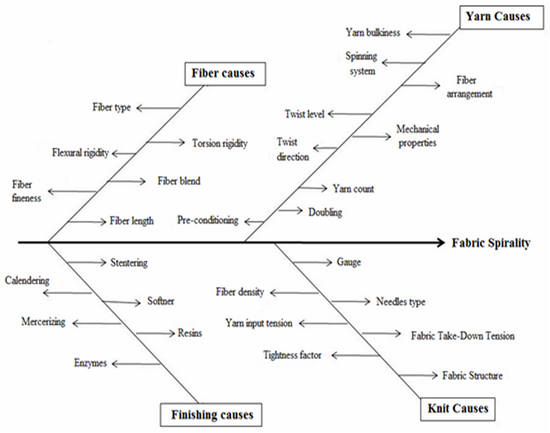Now You Know Causes and Remedies of Spirality for Knitted Fabrics
Tuesday, 22 January 2019
Edit
Causes & Remedies of Spirality of Knitted Fabrics
Spirality of Fabric:
"Spirality" arises from twist stress in the constituents yams of plain fabric, causing all loops to distort and throwing the fabric wales and courses into an angular relationship other than 90 degree.
The ultimate benefit of studying the spirality phenomenon is to understand the various factors influencing the dimensional stability of knit fabrics, particularly fabric spirality so that ways to select appropriate levels of these factors that result in optimum dimensional stability can be established. This can be achieved through a cause and effect analysis of the various potential factors influencing fabric spirality. The importance of cause and effect analysis stems from the fact that several theoretical approaches were taken to analyze the spirality phenomenon, yet because of the complexity of the phenomenon, each study focused on a limited number of factors, either for the sake of simplifying the analysis, or due to limited ability to verify the theory using experimental approaches. The analysis of spirality from strictly experimental view by examining the effects of a number of factors some of which were machine-related and others were fabric-related on the extent of spirality of knit structures. Obviously, there are some approaches resulted in many common causes and effects of this critical phenomenon. However, these were scattered in the bulk of literatures presented to such an extent that makes it difficult for researchers to have a complete view of all factors that can potentially result in an increase or a reduction in knit fabric spirality. There are various causes of fabric spirality and they are divided into four main categories: yarn causes, knit causes, fiber causes, and finishing causes.
 |
| Spirality measurement |
There are different types of causes for occurring fabric spirlity. Course spirality is a very common inherent problem in plain knitted fabrics. The following are some predominant causes of spirality in knitted fabrics.
- Yarn twist multiplier is the principle cause of spirality and it is directly proportional.
- Residual torque in the yarn or the twist liveliness.
- Spirality occurs in knitted fabric because of asymmetric loops which turns in the wales and course of a fabric into an angular relationship other than 90 degree.
- Number of feeders-though higher feeder numbers increases production, spirality also increased.
- Different spinning technologies such as ring, rotor, airjet etc., also influence spirality. The physical properties of these yarns, their geometrical characteristics, their basic fibre properties (i.e. modules, fineness, cross section etc.) and blends are the causes.
- Variation in knitting tension, yarn frictional properties, yarn/metal coefficient of friction, yarn lubrication, number of contact points in the knitting zone i.e. needles and sinkers) also influence spirality.
- Washing wet treatments increases fabric relaxation and also increases spirality.
- Direction of machine rotation has little influence on spirality. Slight inclination of loops occurs in the direction of machine rotation. Multifeed machines rotating clockwise produce spirality to the left and machines rotating anti clock wise produce spirality to the right.
 |
| Causes of spirality of fabric |
- Compacting: Compaction reduces the length of the fabric based on its elongation during processing which, in turn, reduces the width. It helps in controlling the shrinkage of the fabric.
- Resin treatment: Resin treatment known as cross-linking is sometimes used to reduce the degree of distortion due to spirality. The resin is applied to the fabric in aqueous solution and is set by passing the fabric once through a high temperature stenter.
- Heat setting: Steam or hot water setting reduces twist liveliness and hence spirality.
- Balancing yarn twist factor: In an earlier investigation on plain knitted wool fabrics, it was been revealed that raising the twist factor of a ply yarn increases the left-hand of S-direction spirality of fabrics.